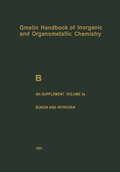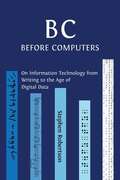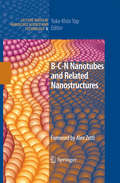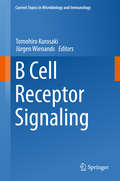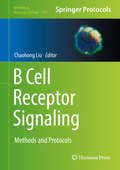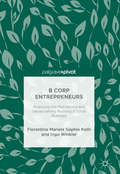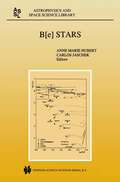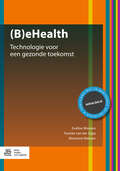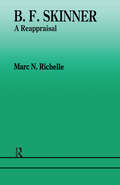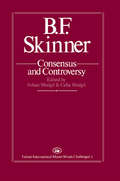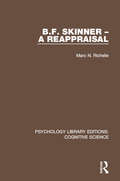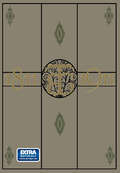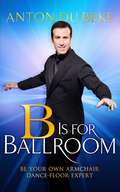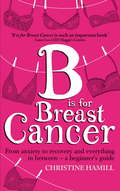- Table View
- List View
B Boron Compounds: 4th Supplement, Boron and Nitrogen (Gmelin Handbook of Inorganic and Organometallic Chemistry - 8th edition #B / 1-20 / 1-4 / 4 / 3 / a)
by Anton MellerThe present issue, Volume 3a of "Boron Compounds" 4th Supplement of the Gmelin Hand book, presents the description of boron nitride and a part of other boron compounds containing nitrogen. Volume 3 b (to be published Later) will complete the presentation of the boron-nitrogen compounds and will also cover boron compounds containing fluorine. Due to technical circumstances, Volume 1 (systems with hydrogen) and Volume 2 (systems with oxygen) of this particular supplement will be published subsequently, whereas Volume 4 (boron compounds containing CL, Br, I, S, Se, and Te, as well as a section containing carboranes) has already been published. ALL volumes of the 4th Supplement will be augmented by a formula index. The IUPAC nomenclature is generally adhered to; occasional abbreviations for compounds are explained in the text. A positive sign for the chemical shifts of the NMR signals indicates a 1 13 downfield shift from the references, usually internal (CH ) Si for 6 H and 6 C and external 3 4 11 (C H h0-BF for 6 B, others being specified. 2 5 3 In contrast to more recent publications but remaining consistent with the previous volumes of the Boron Series, the iminoborane structure is written as B=N and not as B=N. In fact, the real electronic structure is more realistically symbolized by B=N, but it seems reasonable to avoid =NR in accordance with the commonly accepted "iminoborane" nomenclature.
B C, Before Computers: On Information Technology From Writing To The Age Of Digital Data
by Stephen RobertsonB C, Before Computers: On Information Technology From Writing To The Age Of Digital Data
by Stephen RobertsonThe idea that the digital age has revolutionized our day-to-day experience of the world is nothing new, and has been amply recognized by cultural historians. In contrast, Stephen Robertson's BC: Before Computers is a work which questions the idea that the mid-twentieth century saw a single moment of rupture. It is about all the things that we had to learn, invent, and understand - all the ways we had to evolve our thinking - before we could enter the information technology revolution of the second half of the twentieth century. Its focus ranges from the beginnings of data processing, right back to such originary forms of human technology as the development of writing systems, gathering a whole history of revolutionary moments in the development of information technologies into a single, although not linear narrative. <p><p> Treading the line between philosophy and technical history, Robertson draws on his extensive technical knowledge to produce a text which is both thought-provoking and accessible to a wide range of readers. The book is wide in scope, exploring the development of technologies in such diverse areas as cryptography, visual art and music, and the postal system. Through all this, it does not simply aim to tell the story of computer developments but to show that those developments rely on a long history of humans creating technologies for increasingly sophisticated methods of manipulating information. <p> Through a clear structure and engaging style, it brings together a wealth of informative and conceptual explorations into the history of human technologies, and avoids assumptions about any prior knowledge on the part of the reader. As such, it has the potential to be of interest to the expert and the general reader alike.
B C, Before Computers: On Information Technology From Writing To The Age Of Digital Data
by Stephen RobertsonB-C-N Nanotubes and Related Nanostructures (Lecture Notes in Nanoscale Science and Technology #6)
by Yoke Khin YapCarbon nanotubes (CNTs) and Boron nitride nanotubes (BNNTs) are part of the so-called B-C-N material system, which includes novel nanostructures of carbon (C), doped-carbon, boron (B), boron nitride (BN), carbon nitride (CNx), boron-carbon nitride (BxCyNz), and boron carbide (BxCy). BNNTs and CNTs are structurally similar and share extraordinary mechanical properties, but they differ in chemical, biological, optical, and electrical properties. Therefore, hybrid nanotubes constructed of B, C, N elements are expected to form a new class of nanotubes with tunable properties between those of CNTs and BNNTs. In addition, these B-C-N nanostructures will further enhance and complement the applications of CNTs and BNNTs. With contributions from leading experts, B-C-N Nanotubes and Related Nanostructures is the first book to cover all theoretical and experimental aspects of this emerging material system, and meets the need for a comprehensive summary of the tremendous advances in research on B-C-N materials in recent years.
B Cell Protocols (Methods in Molecular Biology #271)
by Hua Gu and Klaus RajewskyB-lymphocyte development and function remains an exciting area of research for those interested in the physiology and pathology of the immune system in higher animals. While recent advances in genetics and cellular and molecular biology have provided a large spectrum of powerful new experimental tools in this field, it is both time consuming and often very difficult for a student or just any bench-side worker to identify a reliable experimental protocol in the ocean of the literature. The aim of B Cell Protocols is to provide a collection of diverse protocols ranging from the latest inventions and applications to some classic, but still frequently used methods in B-cell biology. The authors of the various chapters are all highly qualified scientists who are either the inventors or expert users of these methods. Their extensive experience in mastering a particular method provides not only the step-by-step details of a reproducible protocol, but also useful troubleshooting tips that readers will appreciate in their daily work. We hope that this book will be helpful for both beginning and experienced researchers in the field in designing or modifying an experimental approach, and exploring a biological question from multiple angles.
B Cell Receptor Signaling (Current Topics in Microbiology and Immunology #393)
by Tomohiro Kurosaki Jürgen WienandsThis volume details our current understanding of the architecture and signaling capabilities of the B cell antigen receptor (BCR) in health and disease. The first chapters review new insights into the assembly of BCR components and their organization on the cell surface. Subsequent contributions focus on the molecular interactions that connect the BCR with major intracellular signaling pathways such as Ca2+ mobilization, membrane phospholipid metabolism, nuclear translocation of NF-kB or the activation of Bruton’s Tyrosine Kinase and MAP kinases. These elements orchestrate cytoplasmic and nuclear responses as well as cytoskeleton dynamics for antigen internalization. Furthermore, a key mechanism of how B cells remember their cognate antigen is discussed in detail. Altogether, the discoveries presented provide a better understanding of B cell biology and help to explain some B cell-mediated pathogenicities, like autoimmune phenomena or the formation of B cell tumors, while also paving the way for eventually combating these diseases.
B Cell Receptor Signaling: Methods and Protocols (Methods in Molecular Biology #1707)
by Chaohong LiuThis volume looks the current advanced protocols used to study aspects of the B cell receptor (BCR). The chapters in this book cover topics such as the mutant of BCR repertoire to understand antibody evolution; interactions between B cells and viruses; mechanical force during BCR activation; B cell signaling using flow cytometry; confocal microscopy, total internal reflection microscopy and intravital two-photon microscopy; and the methods used to study critical cell components related with B cell activation. Written in the highly successful Methods in Molecular Biology series format, chapters include introductions to their respective topics, lists of the necessary materials and reagents, step-by-step, readily reproducible laboratory protocols, and tips on troubleshooting and avoiding known pitfalls.Cutting-edge and practical, B Cell Receptor Signaling: Methods and Protocols is a valuable resource for everyone in the scientific community currently working in the B cell field.
B Cells in Immunity and Tolerance (Advances in Experimental Medicine and Biology #1254)
by Ji-Yang WangThis book contains twelve chapters contributed by prestigious international experts who are at the forefront of B cell research, and aims to provide a cutting-edge and comprehensive overview of all aspects of B cells, including B cell development, maturation and activation, germinal center reaction, memory and plasma cell differentiation, and antibody-mediated positive and negative regulation of humoral immune responses. There are also three chapters describing human diseases caused by B cell abnormalities, including primary antibody deficiencies, autoimmune diseases, and B cell malignancies. We hope that this book will become a standard and routine reference for both basic researchers and clinicians.
B Corp Entrepreneurs: Analysing the Motivations and Values behind Running a Social Business
by Florentine Mariele Roth Ingo WinklerHighlighting the motivations of B Corp entrepreneurs in Chile, this book explores the phenomenon behind for-profit organisations that are committed to social and ecological sustainability as well as human welfare. By examining the personal and social drivers of businesses which are not solely focused on profit-making, the authors reveal a dual orientation that is an important factor in the creation of hybrid organisations. Offering an in-depth study of B Corp entrepreneurs in Chile, the largest B Corp community outside of North America, this pioneering book challenges dominant assumptions that there is only one ideal type of entrepreneur and argues that the values of the purely profit-driven and purely social-driven do in fact intersect. An enlightening read for researchers of social business and sustainability, this book analyses perceptions towards success, and the desire to solve environmental problems, underlining a fundamental aspect of the entrepreneur’s personal value structure.
B Corp Entrepreneurs: Analysing the Motivations and Values behind Running a Social Business
by Florentine Mariele Roth Ingo WinklerHighlighting the motivations of B Corp entrepreneurs in Chile, this book explores the phenomenon behind for-profit organisations that are committed to social and ecological sustainability as well as human welfare. By examining the personal and social drivers of businesses which are not solely focused on profit-making, the authors reveal a dual orientation that is an important factor in the creation of hybrid organisations. Offering an in-depth study of B Corp entrepreneurs in Chile, the largest B Corp community outside of North America, this pioneering book challenges dominant assumptions that there is only one ideal type of entrepreneur and argues that the values of the purely profit-driven and purely social-driven do in fact intersect. An enlightening read for researchers of social business and sustainability, this book analyses perceptions towards success, and the desire to solve environmental problems, underlining a fundamental aspect of the entrepreneur’s personal value structure.
B[e] Stars (Astrophysics and Space Science Library #233)
by Anne Marie Hubert Carlos JaschekThe idea of having a meeting came to the Editors when working on several aspects of galactic Be and B[e] stars. They found that a general summary of the properties of B[e] stars was missing, so that the organiza tion of a first meeting on these objects appeared as very useful. B[e] stars have hydrogen line emission and forbidden [Fe 11] and [0 I] emission lines in their spectra; they are also characterized by a strong IR excess due to circumstellar dust. Having a large amount of extinction in the UV and the visual they have been less frequently observed than other emission line objects. Although about one hundred galactic objects have been classified as B[e], only fif teen or so have been studied in some detail. Besides this, the evolutionary status of these objects is rat her controversial, are they pre-main sequence or stars on the way to become nUclei of planetary nebulae? Other difficult problems appear when considering the relations of these stars with other similar groups, like Herbig AeBe stars, Be, luminous blue variables and the superluminous B[e] stars observed in the Magellanic Clouds. The conference seems timely since large surveys like DENIS and 2Mass, plus new space and new instruments for the micron, millimeter and cen timeter wavelength region will result in the discovery of more stars of this group.
B/EB-66 Destroyer Units in Combat (Combat Aircraft)
by Peter E. DaviesStudies of air combat in the Vietnam War inevitably focus on the MiG-killing fighter engagements, B-52 onslaughts or tactical strikes on the Hanoi region. However, underlying all these was the secretive 'electron war' in which highly-skilled electronic warfare officers duelled with Soviet and North Vietnamese radar operators in the attempt to enable US strike forces to reach their targets with minimal losses. Orbiting at the edge of heavily-defended territory, the vulnerable EB-66s identified and jammed the enemy's radar frequencies with electronic emissions and chaff to protect the American bombers. Their hazardous missions resulted in six combat losses, four of them to SA-2 missiles and one to a MiG-21, and they became prime targets for North Vietnamese defences when their importance was realised. This illustrated study focuses on the oft-overlooked B-66 series, examining their vital contributions to the Vietnam War and the bravery of those who operated them in some of the most challenging situations imaginable. Author Peter E. Davies also explores how the technology and tactics devised during the period made possible the development of the EF-111A Raven, an invaluable component of the Desert Storm combat scenario over Iraq and Kuwait in 1991, and the US Navy's EA-6B Prowler, which entered service towards the end of the Vietnam War.
B/EB-66 Destroyer Units in Combat (Combat Aircraft #137)
by Peter E. DaviesStudies of air combat in the Vietnam War inevitably focus on the MiG-killing fighter engagements, B-52 onslaughts or tactical strikes on the Hanoi region. However, underlying all these was the secretive 'electron war' in which highly-skilled electronic warfare officers duelled with Soviet and North Vietnamese radar operators in the attempt to enable US strike forces to reach their targets with minimal losses. Orbiting at the edge of heavily-defended territory, the vulnerable EB-66s identified and jammed the enemy's radar frequencies with electronic emissions and chaff to protect the American bombers. Their hazardous missions resulted in six combat losses, four of them to SA-2 missiles and one to a MiG-21, and they became prime targets for North Vietnamese defences when their importance was realised. This illustrated study focuses on the oft-overlooked B-66 series, examining their vital contributions to the Vietnam War and the bravery of those who operated them in some of the most challenging situations imaginable. Author Peter E. Davies also explores how the technology and tactics devised during the period made possible the development of the EF-111A Raven, an invaluable component of the Desert Storm combat scenario over Iraq and Kuwait in 1991, and the US Navy's EA-6B Prowler, which entered service towards the end of the Vietnam War.
(B)eHealth: Technologie voor een gezonde toekomst
by Eveline Wouters Teatske van der Zijpp Marianne NieboerDit boek helpt je om eHealth te gebruiken ter ondersteuning van de gezondheid van jouw cliënt, en leert je samen met je cliënt te zoeken naar wat technologie kan betekenen in het omgaan met zijn of haar chronische aandoening.Het boek is geschreven vanuit het perspectief van de gebruikers van eHealth: zowel cliënten als behandelaars. Daarbij worden voorbeelden gegeven van eHealth voor veelvoorkomende gezondheidsproblemen uit de praktijk, achtereenvolgens: hartfalen, COPD, dementie, diabetes mellitus, CVA en obesitas. Voor elk van deze chronische gezondheidsproblemen wordt de state-of-the-art beschreven wat betreft achtergrond, diagnostiek en behandeling, de beschikbare evidence over de mogelijkheden van eHealth en ervaringsverhalen van behandelaars en patiënten met eHealth. Ook wordt ingegaan op acceptatie- en implementatievraagstukken van technologie in het zorgdomein, en de rol van persoonlijke copingstijlen en -strategieën van patiënten die het slagen van de toepassing sterk kunnen beïnvloeden.Technologie (eHealth) kan mensen met een chronische aandoening ondersteunen op een groot aantal gebieden. Zo kan eHealth de cliënt helpen gemakkelijk de juiste informatie te vinden over aandoeningen en kan met allerlei applicaties voorlichting en monitoring plaatsvinden.Daarnaast kan eHealth door middel van afstemming, coaching en ook puur organisatorisch steun bieden aan mensen die vaak levenslang te maken hebben met een of meer gezondheidsproblemen. Daarbij biedt het volop kansen cliënten zelf de regie te geven over hun eigen gezondheid.Naast het boek is een website ingericht waar opdrachten voor studenten beschikbaar worden gesteld.Dit boek is bedoeld voor studenten van hbo-zorgopleidingen zoals verpleegkunde, fysiotherapie, logopedie, podotherapie, diëtetiek en ergotherapie. Deze toekomstige zorgprofessionals zullen een veelheid aan nieuwe technologieën in kunnen zetten bij de zorg voor hun cliënten. Ze zullen daarbij in staat moeten zijn de cliënt te begeleiden in het maken van keuzes voor hulpmiddelen die bij hem of haar passen. Dit boek ondersteunt hen daarbij.
B F Skinner
by Marc N. RichelleB.F. Skinner died in August 1990. He had been praised as one of the most influential psychologists of the 20th century, but was also attacked by a variety of opponents within and outside the field of psychology. This introduction to his work is first of all a guide to a correct reading of his writings, a reading devoid of the distortions and misinterpretations often conveyed by many commentators, including psychologists. It frames Skinner's contributions with reference to major European traditions in psychological sciences, namely Pavlov, Freud, Lorenz and Piaget. Crucial aspects of Skinner's theory and methodological stands are discussed in the context of contemporary debates: special attention is devoted to the relationship of psychology with biology and the neurosciences, to the cognitivist movement, to the status of language and to the explanation of novelty and creativity in human behaviour.; Finally, Skinner's social and political philosophy is presented with an emphasis on the provocative aspects of an analysis of current social practices which fail to solve most of the urgent problems humankind is confronted with today. Both in science proper and in human affairs at large, Skinner's thought is shown to be not behind, as is often claimed, but ahead of the times, be it in his interactive view of linguistic communication, in his very modern use of the evolutionary analogy to explain the dynamics of behaviour, or in his vision of ecological constraints.
B F Skinner: A Reappraisal (Psychology Library Editions: Cognitive Science Ser.)
by Marc N. RichelleB.F. Skinner died in August 1990. He had been praised as one of the most influential psychologists of the 20th century, but was also attacked by a variety of opponents within and outside the field of psychology. This introduction to his work is first of all a guide to a correct reading of his writings, a reading devoid of the distortions and misinterpretations often conveyed by many commentators, including psychologists. It frames Skinner's contributions with reference to major European traditions in psychological sciences, namely Pavlov, Freud, Lorenz and Piaget. Crucial aspects of Skinner's theory and methodological stands are discussed in the context of contemporary debates: special attention is devoted to the relationship of psychology with biology and the neurosciences, to the cognitivist movement, to the status of language and to the explanation of novelty and creativity in human behaviour.; Finally, Skinner's social and political philosophy is presented with an emphasis on the provocative aspects of an analysis of current social practices which fail to solve most of the urgent problems humankind is confronted with today. Both in science proper and in human affairs at large, Skinner's thought is shown to be not behind, as is often claimed, but ahead of the times, be it in his interactive view of linguistic communication, in his very modern use of the evolutionary analogy to explain the dynamics of behaviour, or in his vision of ecological constraints.
B.F. Skinner: Consensus And Controversy
by Sohan Modgil Celia ModgilPublished in the year 1987, B.F.Skinner: Consensus and Contribution is a valuable contribution to the field of Education.
B.F. Skinner: Consensus And Controversy
by Sohan Modgil and Celia ModgilPublished in the year 1987, B.F.Skinner: Consensus and Contribution is a valuable contribution to the field of Education.
B.F. Skinner - A Reappraisal (Psychology Library Editions: Cognitive Science)
by Marc N. RichelleB.F. Skinner died in August 1990. He was praised as one of the most influential psychologists of this century, but was also attacked by a variety of opponents within and outside the field of psychology. Originally published in 1993, this introduction to his work is first of all a guide to a correct reading of his writings, a reading void of the distortions and misinterpretations often conveyed by many commentators, including psychologists. It frames Skinner’s contributions with reference to major European traditions in psychological sciences, namely Pavlov, Freud, Lorenz and Piaget. Crucial aspects of Skinner’s theory and methodological stands are discussed in the context of contemporary debates: special attention is devoted to the relation of psychology with biology and the neurosciences, to the cognitivist movement, to the status of language and to the explanation of novelty and creativity in human behaviour. Finally, Skinner’s social and political philosophy is presented with an emphasis on the provocative aspects of an analysis of current social practices which fail to solve most of the urgent problems humankind is confronted with today. Both in science proper and in human affairs at large, Skinner’s thought is shown to be, not behind, as is often claimed, but on the contrary ahead of the times, be it in his interactive view of linguistic communication, in his very modern use of the evolutionary analogy to explain the dynamics of behaviour, or in his vision of ecological constraints. Written by a European psychologist, the book departs from traditional presentations of Skinner’s work in the frame of American psychology. It will provide the reader, who is unfamiliar with the great behaviourist’s writings, a concise yet in-depth introduction to his work.
B.F. Skinner - A Reappraisal (Psychology Library Editions: Cognitive Science)
by Marc N. RichelleB.F. Skinner died in August 1990. He was praised as one of the most influential psychologists of this century, but was also attacked by a variety of opponents within and outside the field of psychology. Originally published in 1993, this introduction to his work is first of all a guide to a correct reading of his writings, a reading void of the distortions and misinterpretations often conveyed by many commentators, including psychologists. It frames Skinner’s contributions with reference to major European traditions in psychological sciences, namely Pavlov, Freud, Lorenz and Piaget. Crucial aspects of Skinner’s theory and methodological stands are discussed in the context of contemporary debates: special attention is devoted to the relation of psychology with biology and the neurosciences, to the cognitivist movement, to the status of language and to the explanation of novelty and creativity in human behaviour. Finally, Skinner’s social and political philosophy is presented with an emphasis on the provocative aspects of an analysis of current social practices which fail to solve most of the urgent problems humankind is confronted with today. Both in science proper and in human affairs at large, Skinner’s thought is shown to be, not behind, as is often claimed, but on the contrary ahead of the times, be it in his interactive view of linguistic communication, in his very modern use of the evolutionary analogy to explain the dynamics of behaviour, or in his vision of ecological constraints. Written by a European psychologist, the book departs from traditional presentations of Skinner’s work in the frame of American psychology. It will provide the reader, who is unfamiliar with the great behaviourist’s writings, a concise yet in-depth introduction to his work.
B.G. Teubner 1811–1911: Geschichte der Firma
by Friedrich Schulze Walter Tiemann Hans Alexander MüllerDieser Buchtitel ist Teil des Digitalisierungsprojekts Springer Book Archives mit Publikationen, die seit den Anfängen des Verlags von 1842 erschienen sind. Der Verlag stellt mit diesem Archiv Quellen für die historische wie auch die disziplingeschichtliche Forschung zur Verfügung, die jeweils im historischen Kontext betrachtet werden müssen. Dieser Titel erschien in der Zeit vor 1945 und wird daher in seiner zeittypischen politisch-ideologischen Ausrichtung vom Verlag nicht beworben.
B is for Ballroom: Be Your Own Armchair Dancefloor Expert
by Anton du BekeDo you know your Botafago from your Volta Cross? Ever wondered how the Foxtrot got its name? Why is the Quick Step so quick? Which is easier, the standard Ballroom dances or the Latin ones? If you don't know the answer to most of these questions but fancy yourself as something of an armchair aficionado when it comes to Ballroom dancing, this book is for you. It will lead you into the wonderful world of Ballroom and teach you everything you need to know, without, if necessary, you even having to reach for your dancing shoes. As you'll soon discover, B is for Ballroom does exactly what the title suggests. Set out in an A to Z format it's the ultimate companion for anyone interested in Ballroom - whether you're nine years old or over ninety. It will teach you everything you need to know about this most beloved form of dance without you even having to take a class, break a leg or be dragged across the floor.
B is for Bauhaus: An A-Z of the Modern World
by Deyan SudjicThis book is not a dictionary, though it tells you all you need know about everything from Authenticity to Zips. It's not an autobiography, though it does offer a revealing and highly personal inside view of contemporary culture.It's an essential tool kit for understanding the modern world. It's about what makes a Warhol a genuine fake; the creation of national identities; the mania to collect. It's also about the world seen from the rear view mirror of Grand Theft Auto V; digital ornament and why we value imperfection. It's about drinking a bruisingly dry martini in Adolf Loo's American bar in Vienna, and about Hitchcock's film sets. It's about fashion and technology, about politics and art.
B is for Breast Cancer: From anxiety to recovery and everything in between - a beginner's guide
by Christine Hamill'The day after I was diagnosed with breast cancer, I was standing in the chemist with a basket in my hand, blinking back tears and thinking, "Now what does a breast cancer patient need?" All I could come up with was waterproof mascara. I put some in my basket and thought someone should write an alternative guide to breast cancer. Step one - buy waterproof mascara. You're going to need it. A few short months later, I found I was writing the guide myself. I sat in bed in between hospital appointments with my laptop, furiously, desperately trying to make sense of this alien world I had entered.'Written entirely while Christine Hamill was undergoing cancer treatment, this book is an honest and frank account of the emotional and physical impact of a cancer diagnosis. It is at turns funny, sad, angry and ultimately optimistic. Written without sentimentality, B is for Breast Cancer offers bite-size chunks of help and hope - a daily pep talk to anyone affected by the disease. It's packed full of the practical information that you really need.Read this book. It helps to know you are not alone.
